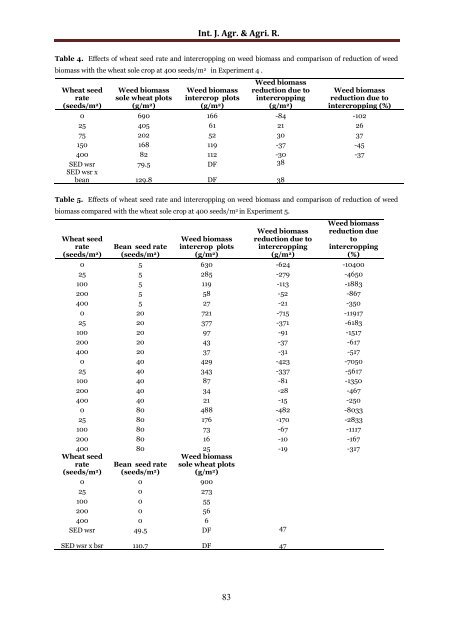Suppressing weed biomass as influenced by seeding rate in wheat/faba bean intercropping system
The effect of seeding rate (sr), sulphur fertilization and intercropping on weed suppression in wheat (Triticum aestivum L.)/faba bean (Vicia faba L; bean) intercropping system is not well investigated. Field experiments were carried out to study the effects of wide sr (0-650 wheat seeds/m2; not in all experiment) in addition to the other aforementioned cultural practices on weed suppression or weed biomass. Without the application of herbicide, weeds were suppressed well at the higher wheat sr under both the conventional and organic management system. However, in three other conventional experiments when herbicide was applied these benefits were reduced substantially. Averaged across wheat sr in one-experiment weed biomasses found were 185 g/m2 and 36 g/m2 for without and with bean treatment respectively. However, for the combined effects of wheat sr and bean treatment, compared to the sole crop with the highest wheat sr, intercropping was poorer than sole crop in controlling weeds, in several but not all experiments. Nevertheless in one experiment at 10-wheat seeds/m2, weed biomass were 336 g/m2 and 53 g/m2 for the wheat sole crop and intercrop (40-bean seeds/m2) respectively. Thus, illustrating the practical benefits of using both sr and intercropping to suppress weeds at the lower densities.
The effect of seeding rate (sr), sulphur fertilization and intercropping on weed suppression in wheat (Triticum aestivum L.)/faba bean (Vicia faba L; bean) intercropping system is not well investigated. Field experiments were carried out to study the effects of wide sr (0-650 wheat seeds/m2; not in all experiment) in addition to the other aforementioned cultural practices on weed suppression or weed biomass. Without the application of herbicide, weeds were suppressed well at the higher wheat sr under both the conventional and organic management system. However, in three other conventional experiments when herbicide was applied these benefits were reduced substantially. Averaged across wheat sr in one-experiment weed biomasses found were 185 g/m2 and 36 g/m2 for without and with bean treatment respectively. However, for the combined effects of wheat sr and bean treatment, compared to the sole crop with the highest wheat sr, intercropping was poorer than sole crop in controlling weeds, in several but not all experiments. Nevertheless in one experiment at 10-wheat seeds/m2, weed biomass were 336 g/m2 and 53 g/m2 for the wheat sole crop and intercrop (40-bean seeds/m2) respectively. Thus, illustrating the practical benefits of using both sr and intercropping to suppress weeds at the lower densities.
You also want an ePaper? Increase the reach of your titles
YUMPU automatically turns print PDFs into web optimized ePapers that Google loves.
Int. J. Agr. & Agri. R.<br />
Table 4. Effects of <strong>wheat</strong> seed <strong>rate</strong> and <strong>in</strong>tercropp<strong>in</strong>g on <strong>weed</strong> <strong>biom<strong>as</strong>s</strong> and comparison of reduction of <strong>weed</strong><br />
<strong>biom<strong>as</strong>s</strong> with the <strong>wheat</strong> sole crop at 400 seeds/m 2 <strong>in</strong> Experiment 4 .<br />
Wheat seed<br />
<strong>rate</strong><br />
(seeds/m 2 )<br />
Weed <strong>biom<strong>as</strong>s</strong><br />
sole <strong>wheat</strong> plots<br />
(g/m 2 )<br />
Weed <strong>biom<strong>as</strong>s</strong><br />
<strong>in</strong>tercrop plots<br />
(g/m 2 )<br />
Weed <strong>biom<strong>as</strong>s</strong><br />
reduction due to<br />
<strong>in</strong>tercropp<strong>in</strong>g<br />
(g/m 2 )<br />
Weed <strong>biom<strong>as</strong>s</strong><br />
reduction due to<br />
<strong>in</strong>tercropp<strong>in</strong>g (%)<br />
0 690 166 -84 -102<br />
25 405 61 21 26<br />
75 202 52 30 37<br />
150 168 119 -37 -45<br />
400 82 112 -30 -37<br />
SED wsr 79.5 DF 38<br />
SED wsr x<br />
<strong>bean</strong> 129.8 DF 38<br />
Table 5. Effects of <strong>wheat</strong> seed <strong>rate</strong> and <strong>in</strong>tercropp<strong>in</strong>g on <strong>weed</strong> <strong>biom<strong>as</strong>s</strong> and comparison of reduction of <strong>weed</strong><br />
<strong>biom<strong>as</strong>s</strong> compared with the <strong>wheat</strong> sole crop at 400 seeds/m 2 <strong>in</strong> Experiment 5.<br />
Wheat seed<br />
<strong>rate</strong><br />
(seeds/m 2 )<br />
Bean seed <strong>rate</strong><br />
(seeds/m 2 )<br />
Weed <strong>biom<strong>as</strong>s</strong><br />
<strong>in</strong>tercrop plots<br />
(g/m 2 )<br />
Weed <strong>biom<strong>as</strong>s</strong><br />
reduction due to<br />
<strong>in</strong>tercropp<strong>in</strong>g<br />
(g/m 2 )<br />
Weed <strong>biom<strong>as</strong>s</strong><br />
reduction due<br />
to<br />
<strong>in</strong>tercropp<strong>in</strong>g<br />
(%)<br />
0 5 630 -624 -10400<br />
25 5 285 -279 -4650<br />
100 5 119 -113 -1883<br />
200 5 58 -52 -867<br />
400 5 27 -21 -350<br />
0 20 721 -715 -11917<br />
25 20 377 -371 -6183<br />
100 20 97 -91 -1517<br />
200 20 43 -37 -617<br />
400 20 37 -31 -517<br />
0 40 429 -423 -7050<br />
25 40 343 -337 -5617<br />
100 40 87 -81 -1350<br />
200 40 34 -28 -467<br />
400 40 21 -15 -250<br />
0 80 488 -482 -8033<br />
25 80 176 -170 -2833<br />
100 80 73 -67 -1117<br />
200 80 16 -10 -167<br />
400 80 25 -19 -317<br />
Wheat seed<br />
<strong>rate</strong><br />
(seeds/m 2 )<br />
Weed <strong>biom<strong>as</strong>s</strong><br />
sole <strong>wheat</strong> plots<br />
(g/m 2 )<br />
Bean seed <strong>rate</strong><br />
(seeds/m 2 )<br />
0 0 900<br />
25 0 273<br />
100 0 55<br />
200 0 56<br />
400 0 6<br />
SED wsr 49.5 DF 47<br />
SED wsr x bsr 110.7 DF 47<br />
83


















